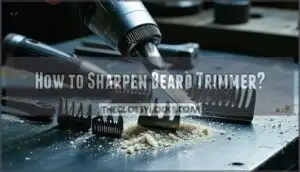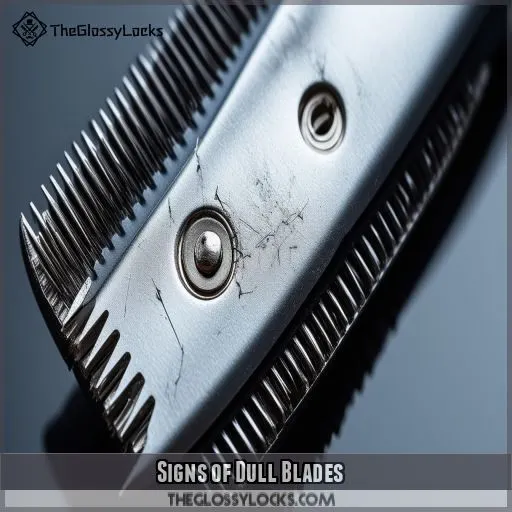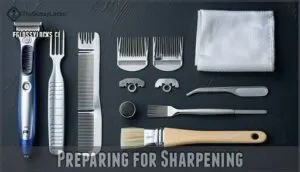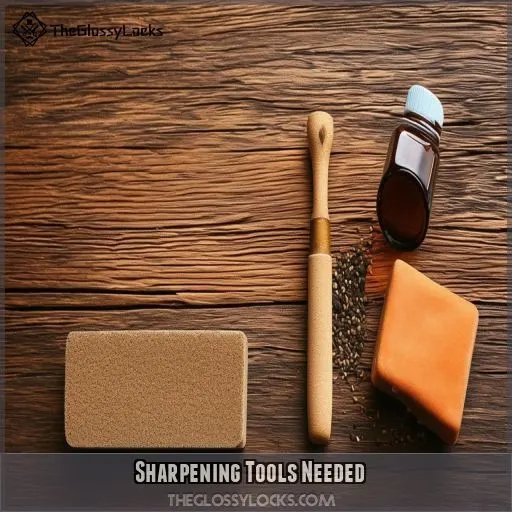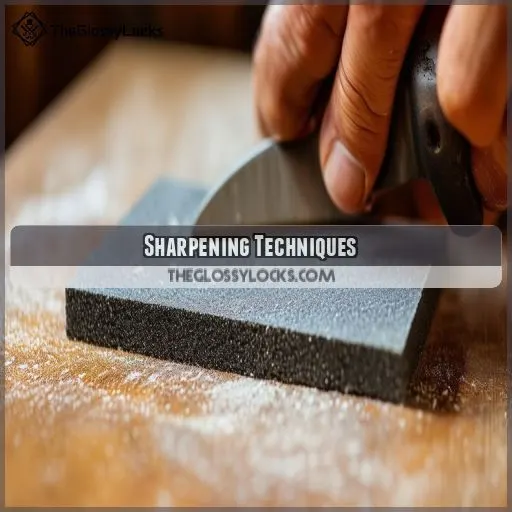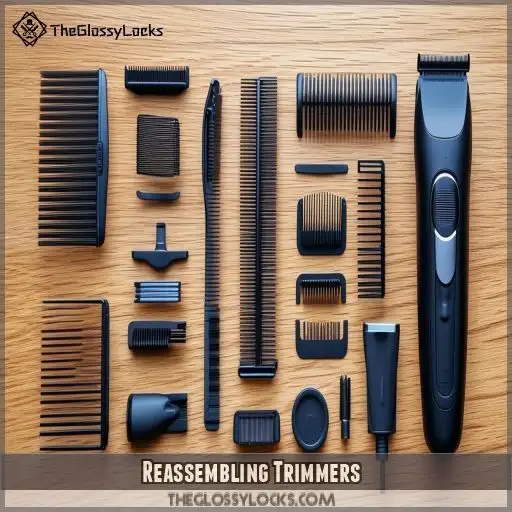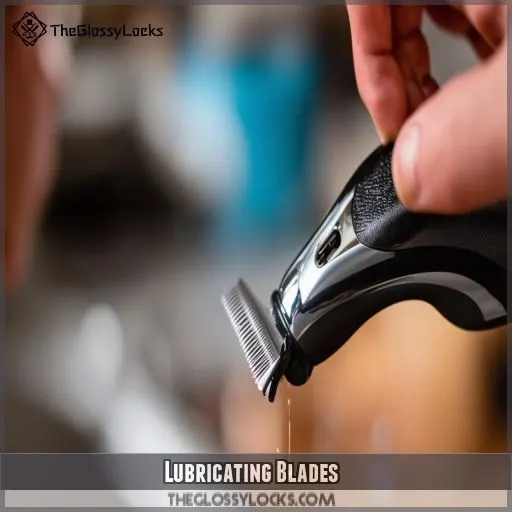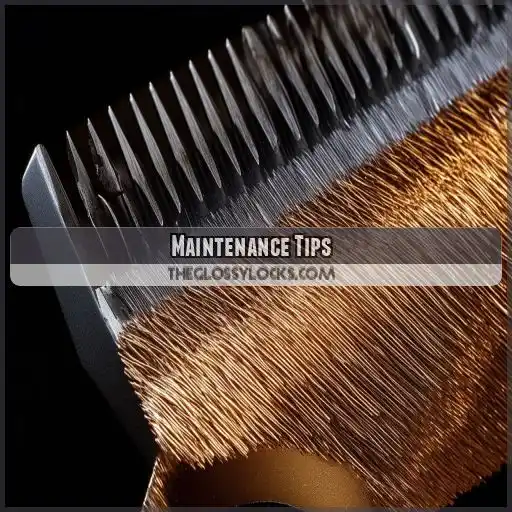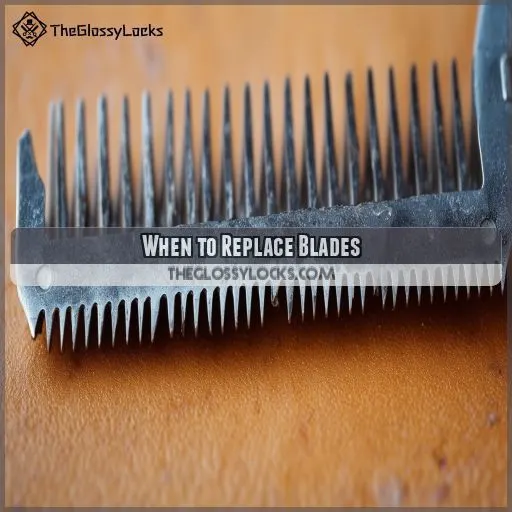This site is supported by our readers. We may earn a commission, at no cost to you, if you purchase through links.
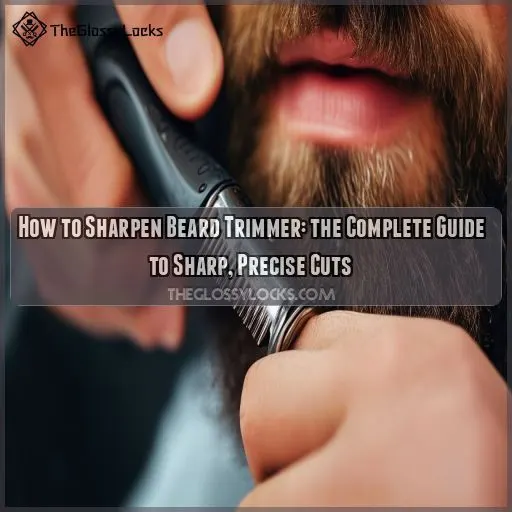
First, disassemble and thoroughly clean the blades to remove buildup.
With sharpening stones, start with a coarse grit and work up to a finer grit, maintaining the blade’s angle.
Honing rods realign and refine the edge.
Electric sharpeners offer convenience but require care to avoid overheating.
Regular sharpening every 4-6 weeks guarantees precise, smooth cuts when trimming your beard.
With a little practice, you’ll master the technique for long-lasting sharpness.
Table Of Contents
- Key Takeaways
- How to Sharpen Beard Trimmer?
- Why Sharpen Trimmers?
- Signs of Dull Blades
- Preparing for Sharpening
- Sharpening Tools Needed
- Sharpening Techniques
- Reassembling Trimmers
- Lubricating Blades
- Maintenance Tips
- When to Replace Blades
- Frequently Asked Questions (FAQs)
- How do you sharpen beard trimmers at home?
- Do beard trimmers need to be sharpened?
- How do you make trimmers sharper?
- How to keep a beard trimmer sharp?
- Can you sharpen trimmer blades at home?
- How often should trimmer blades be sharpened?
- Are electric sharpeners better than manual sharpening?
- What grit sharpening stones should be used?
- How do you protect trimmer blades from rust?
- Conclusion
Key Takeaways
- Sharpening your beard trimmer is like giving your trusty steed a fresh set of horseshoes – it keeps your grooming game galloping smoothly. With a bit of elbow grease and the right tools (sharpening stones, honing rods, or electric sharpeners), you’ll turn those dull blades into precision beard-sculpting instruments.
- Imagine your trimmer blades as a mini samurai sword – they need regular TLC to stay sharp and true. Clean off the gunk, oil them up with the good stuff (clipper oil, not that old motor oil you found in the garage), and sharpen every 4-6 weeks. Your beard will thank you by not looking like it got in a fight with a lawnmower.
- When it comes to sharpening, you’ve got options. Manual methods like stones and rods are like learning to play guitar by ear – it takes practice, but the control and satisfaction are worth it. Electric sharpeners are more like autotune – quick and easy, but you might miss out on some of the artistry.
- Remember, even the mightiest Vikings had to replace their battle-axes eventually. When your trimmer blades start acting more like a weed whacker than a precision tool, it’s time to bid them farewell. But with your new blade-whispering skills, you’ll keep your trimmer (and your beard) in tip-top shape for many glorious grooming adventures to come.
How to Sharpen Beard Trimmer?
To sharpen a beard trimmer, carefully disassemble it, clean the blades, and use sharpening tools like stones, honing rods, or electric sharpeners to restore the blade’s edge. Maintaining sharp blades ensures precise cuts and prolongs the life of your trimmer, so regular sharpening and proper cleaning are essential for good performance.
Why Sharpen Trimmers?
You’ve invested in quality beard trimmers, but over time, those blades lose their edge. Regular sharpening benefits you by maintaining precise trimming, preventing dreaded tugging or snagging. It’s a cost-effective DIY approach to extend your blade’s longevity. With the right sharpening kit and technique, you’ll achieve clean, smooth cuts while mastering expert-level beard maintenance.
Signs of Dull Blades
You’ll know it’s time to sharpen your trimmer’s blades when you notice hair buildup, rust formation, or signs of metal fatigue.
Dull blades tug at hair, provide an uneven trim, and require more passes.
Proper maintenance like frequent sharpening, regular cleaning, and using the right blade oil can prolong their lifespan.
Replacement is inevitable.
Monitor for tugging, pulling, uneven cuts – these indicate it’s sharpening time.
A quality sharpener or sharpening stone restores precision for smooth, clean trims.
Preparing for Sharpening
Before sharpening your beard trimmer’s blades, you’ll need to properly disassemble the trimmer and thoroughly clean the blades to remove any built-up hair, debris, or oils that could hinder the sharpening process. Taking the time to prepare the blades guarantees an effective sharpening result and extends the longevity of your trimmer.
Disassembling Trimmers
To prepare your trimmer for sharpening, first locate a precision screwdriver that fits the tiny screws securing the blades.
Carefully remove all screws, noting their order and positioning for easy reassembly later.
With a steady hand, gently detach the blades, keeping track of which is the top and bottom to maintain their alignment.
Identify any washers or spacers, setting them aside neatly.
For electric sharpeners or honing rods, refer to the manufacturer’s guide for proper blade removal.
With focus and patience, you’re now ready to sharpen those dulled edges to zero-gapped glory.
Cleaning Blades
It’s time to give those blades some TLC before sharpening.
First, grab a wire brush, steel wool, or an old toothbrush – whatever you have on hand for scrubbing duty. Carefully remove any hair, gunk, or buildup from the blades.
For stubborn grime, reach for a blade wash or isopropyl alcohol. Scrub gently but thoroughly until those blades gleam.
Once cleaned, pat them dry with a clean towel.
Don’t skip this important step – sharpening clean blades guarantees a smoother, more precise edge for your beard care routine.
Sharpening Tools Needed
To sharpen your beard trimmer effectively, you’ll need a few essential tools: sharpening stones (whetstones) of varying grits, a honing rod for realigning the blade edge, and potentially an electric sharpener for convenience, although mastering manual sharpening is preferable for better control and results.
Sharpening Stones
For sharpening stones, you’ll need:
- Coarse (400-600 grit) stone for major reshaping
- Medium (1000-2000 grit) for initial sharpening
- Fine (4000-8000 grit) for final honing
Follow the sharpening angle (30-45°) and use consistent strokes. Flatten stones regularly to maintain an even surface. With proper technique, stones provide a razor-sharp, precise edge.
Honing Rods
Honing rods align and refine your trimmer’s cutting edge. Apply light, consistent honing pressure with a back-and-forth motion. Consider a handheld sharpener with concave stones to match your blades’ curvature. Proper maintenance extends your trimmer’s life and guarantees precise cuts.
| Honing Tips | Technique | Benefits |
|---|---|---|
| Light pressure | Back-and-forth motion | Aligns edge |
| Match blade curvature | Concave stones | Uniform sharpening |
| Consistent maintenance | Regular honing | Extends blade life |
Electric Sharpeners
An electric sharpener offers convenience by automating the sharpening process. Popular brands like Andis and Wahl offer reliable models. While pricier than manual tools, they save time and effort. Follow manufacturer instructions for maintenance and safety. Monitor for overheating or damage. With proper use, an electric sharpener provides consistent, sharp results every time.
Sharpening Techniques
For sharpening your beard trimmer blades, you have three main options: using sharpening stones, honing rods, or an electric sharpener. Each method has its own advantages, so we’ll explore the techniques for using stones, rods, and electric sharpeners to achieve razor-sharp edges on your trimmer blades.
Using Sharpening Stones
For truly sharp blades, you’ll need quality sharpening stones. A concave blade demands a convex stone like:
- A diamond plate for initial sharpening
- A ceramic bench stone for refining the edge
- A flat lap for polishing and deburring
Apply light pressure and make overlapping strokes, ensuring even material removal across the blade’s curve.
Using Honing Rods
After sharpening with stones, you’ll want to hone the blades. Grip the honing rod comfortably, applying moderate pressure. Angle the blades at around 20-30 degrees and stroke the rod along the full length in one direction. Repeat 5-10 times per side, maintaining consistent angle and pressure. Hone weekly for ideal edge.
Using Electric Sharpeners
Electric sharpeners offer a quick and convenient way to sharpen your trimmer blades. Simply:
- Remove the blades from the trimmer.
- Clean them thoroughly.
- Insert them into the sharpener per the manufacturer’s instructions.
Run the sharpener for the recommended time, and voilà! Perfectly honed blades, ready to deliver a precise, professional trim every time. While more expensive than manual methods, electric sharpeners save time and effort, making them ideal for busy groomers.
Reassembling Trimmers
With your blade edges now razor-sharp, it’s time to reassemble your trimmers. Carefully reattach the blades, ensuring proper alignment and spacing – a magnetic holder can aid precision. Tighten the screws firmly to secure the blades in position. Double-check for proper blade alignment and spacing adjustment before proceeding to avoid any future issues.
Lubricating Blades
After reassembly, properly lubricating the blades is imperative. Apply a few drops of premium clipper oil onto the blades, then activate the trimmer to evenly distribute the lubricant. This process helps prevent corrosion, minimizes friction, and extends blade lifespan. Refrain from using heavy oils or lubricants not specifically formulated for trimmers, as these can accumulate dirt and debris over time.
Maintenance Tips
To maintain sharp, precise cuts, you’ll want to sharpen your beard trimmer blades regularly – a good rule of thumb is every 4-6 weeks for home use. Proper cleaning after each use and applying only high-quality clipper oil will also help extend the lifespan of your trimmer blades.
Frequency of Sharpening
Blade sharpness directly impacts cutting precision and performance. As blades wear, you’ll notice decreased effectiveness and uneven trimming results. Higher-quality blades resist dulling longer but still require regular sharpening. For satisfactory results, sharpen your trimmer blades every 4-6 uses. Frequent sharpening maximizes blade life, ensures safety, and delivers a clean, close cut without snagging or irritation.
Proper Cleaning
Proper cleaning is essential for blade care. After each use, gently brush away hair and debris with a soft-bristle brush or toothpick. For stubborn buildup:
- Soak blades in clipper cleaner or isopropyl alcohol
- Scrub gently with a wire brush or steel wool
- Rinse and dry thoroughly
Rust can damage blades, so promptly remove any rust using a rust-removing solution. With diligent cleaning, your trimmer stays sharp and precise.
Suitable Lubricants
After cleaning, extend your blades’ lifespan and prevent rust by using only high-quality clipper oil specifically formulated for trimmer lubrication. Avoid heavy, dark oils that can gunk up the blades. Lightly lubricate after every few uses with just a couple drops:
| Oil Type | Frequency |
|---|---|
| Clipper Oil | Every 2-3 uses |
| Synthetic | Every 4-5 uses |
| None | Never |
Proper oiling guarantees smooth, precise trimming while protecting your investment.
When to Replace Blades
You’ll know it’s time to replace your trimmer blades when sharpening no longer provides a crisp, smooth cut. Telltale signs include:
- Excessive blade wear or thinning
- Chipped or cracked blades
- Blades staying dull after sharpening
Even with diligent maintenance, blades eventually wear out due to:
- Frequent use over time
- Inferior blade materials
- Cutting coarse, thick hair
When blade replacement costs exceed a new trimmer, it’s more economical to invest in a new, quality model.
Frequently Asked Questions (FAQs)
How do you sharpen beard trimmers at home?
Uncover the secret to precise grooming: gently remove blades, brush away debris, hone with sharpening stone at 30-45° angle for a finely calibrated edge. Master your trimmer like a true artisan.
Do beard trimmers need to be sharpened?
Yes, beard trimmers need regular sharpening to maintain their cutting edge. Dull blades tug on hairs, causing irritation and an uneven trim. To keep your beard trimmer in top condition, use it alongside a best body groomers for a complete grooming experience. Sharpen every few months using a quality sharpening tool for satisfactory grooming results.
How do you make trimmers sharper?
Sharpening trimmers is like restoring an artist’s brush – a delicate process. Remove blades, clean buildup, then hone on fine grit stones using circular motions. Repeat regularly for a precise, controlled trim every time.
How to keep a beard trimmer sharp?
Regularly clean and sharpen your beard trimmer’s blades to maintain their sharpness. Use a high-quality sharpening stone, applying gentle pressure while stroking the blades. Proper lubrication with clipper oil after sharpening also helps prolong blade life.
Can you sharpen trimmer blades at home?
Yes, you can sharpen trimmer blades yourself using a sharpening stone or file. It takes some practice, but provides good control over the sharpening process and blade angle. Just be careful not to overdo it and ruin the blades.
How often should trimmer blades be sharpened?
You should sharpen your trimmer blades every 2-3 uses to maintain ideal performance. Regular sharpening prevents tugging, ensures smooth cuts, and extends blade life. Don’t forget to clean after each use for best results.
Are electric sharpeners better than manual sharpening?
Electric sharpeners offer speed and convenience, but manual methods give you more control. For precision and longevity, mastering manual sharpening techniques can be rewarding. However, if time’s tight, an electric sharpener can still get the job done effectively.
What grit sharpening stones should be used?
Start with a coarse 4000 grit stone for initial sharpening, then move to an 8000 grit for fine honing. These grits provide the perfect balance of material removal and edge refinement, ensuring your blades stay sharp and efficient.
How do you protect trimmer blades from rust?
Like a knight’s armor, shield your trimmer blades from rust’s corrosive assault. After each use, brush off hair, wipe with blade wash or isopropyl alcohol, and dry thoroughly. Apply a few drops of clipper oil to keep your trusty blades battle-ready.
Conclusion
Practice makes perfect in learning how to sharpen beard trimmer blades.
By following this guide, you’ll revitalize your trimmer, ensuring it delivers clean, precise cuts consistently.
Remember to clean, sharpen, and lubricate your blades periodically, using the correct tools and techniques.
With proper maintenance, your trimmer will retain its sharpness for a longer duration, saving you time and expenses.
Mastering this skill signifies you’ll always have a well-groomed beard that turns heads for all the right reasons.

